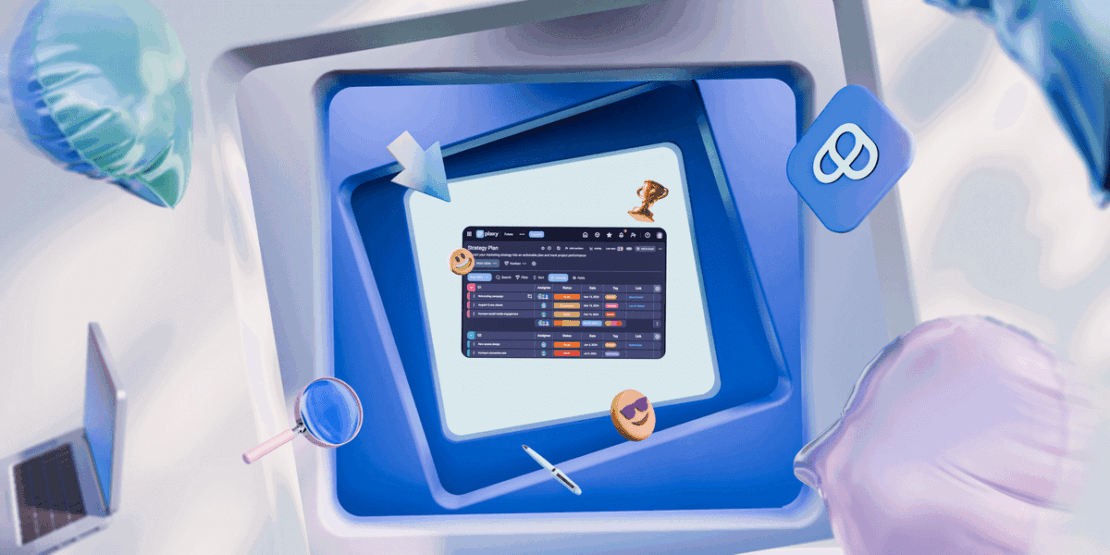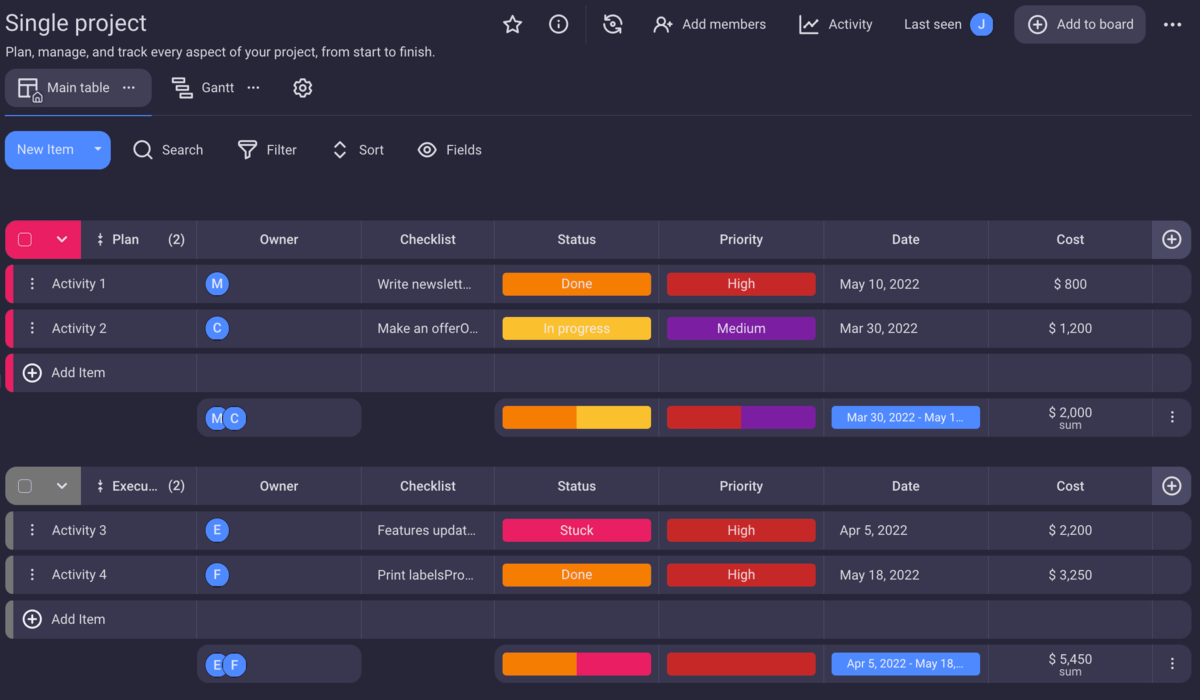Project management and product management are two terms that often get confused due to sounding similar and using the same acronym (PM).
However, they are profoundly different.
If they’re working on the same thing, a project manager and a product manager will go about it in completely different ways, following different success metrics.
In this article, we’ll explain the differences between project management and product management, along with some differences that can only be explained at the level of project and product managers.

In this article:
Project management vs product management — key takeaways
| Project management | Product management |
|---|---|
| Time-limited | Ongoing process |
| The goal is to complete the final deliverable | The goal is to make a profitable solution for the customers’ problems |
| Success is measured by finishing the project on time and on budget | Success is measured using KPIs |
| The project manager carries out the vision | The product manager creates the vision |
| The project manager communicates with stakeholders and the project team | The product manager communicates with stakeholders, engineers, and customers |
| The project manager has direct authority over the project and its team | The product manager doesn’t have any direct authority — nobody reports to them |
What are the differences between project management and product management?
The key difference between project management and product management lies in their goals.
The goal of project management is to complete the final deliverable within time and budget. If the project is to create a streaming service, then the project management side of things is tasked with making sure it functions (the menu navigation is smooth, the videos don’t stutter, the suggestion algorithm functions properly, etc.). Project management does not concern itself with the streaming service’s profitability or content library.
The goal of product management is to fix the customers’ problems by guiding product development in a way that improves user value. Among other things, product management advocates for new features, creates the product roadmap, handles marketing, and sets the subscription price. Its responsibility is to keep the service profitable by addressing customer needs.
In short, the product manager creates a vision, while the project manager makes it happen.
This is the key difference, but it’s not the only one, so let’s check some other notable differences.
💡 Plaky Pro Tip
Project management gets confused with a lot of other types of management with product management being only one of them. To learn more about this, read the following articles:
Projects end, products don’t
A project is a time-limited endeavor (i.e., it has a beginning and an end) whose purpose is to create the final project deliverable.
Different sources phrase this differently, but they all agree that projects have finite timespans — it’s one of their defining characteristics.
When the final deliverable is made, the project is finished and the project team disbands.
The Product Development and Management Association (PDMA) defines product as “all goods, services, and knowledge sold.”
If you run a service, you have to continuously update it to stay ahead of the competition and respond to new user demands.
Services can end, of course, but typically this happens because they are unsuccessful and get shut down. The goal of the service is to keep going.
The same goes for all products, but services best illustrate this point.
Projects are client-oriented, products are user-oriented
Project management exists as a means of delivering to the client what they want. What the client wants, goes. In fact, there wouldn’t even be a project to manage in the first place if the client didn’t need something. You can replace the word client with stakeholders in some cases, but the point stands.
On the other hand, product management is customer- or user-focused. It exists to solve their problems. Granted, you want to do this in a profitable manner — the best solution is one that someone would pay for — but the focus is always on solving their problems.

Project management fulfills contractual obligations, product management elevates the product
The metrics used to measure success differ greatly between project management and product management.
A project is successful if it’s delivered on time and on budget. In project management, quality is only important insofar as it is defined by the project scope. Some project teams will include extra features that are not part of the original project scope — this is known as gold plating — but this is an exception, rather than the rule.
On the other hand, a product is successful if it’s profitable. This is why key performance indicators (KPIs) are used to measure the success of product management.
💡 Plaky Pro Tip
Find out which product management tools are attracting the most attention in 2025 in the post below:
For a product to be profitable, it needs to offer solutions to problems that customers are willing to pay for. So, to measure the success of a streaming service, we might look at streaming-related KPIs such as the total number of users, session duration, subscriber churn rate, or average revenue per user. Different products would require different KPIs.
We have to reiterate that the goal of product management is to fix the customer’s problems. Negative KPIs might lead companies to try and fix their own problems, for example, by increasing the price of a subscription due to low revenue. This would be bad product management since the customer doesn’t care about your problem.
In such cases, the solution is usually to counterbalance the price increase with new features that provide value customers would be willing to pay extra for.
Project managers hold authority, product managers don’t
It sounds preposterous that product managers don’t have authority over product development — especially given how they’re often called the CEOs of products — but it’s true.
Product managers lack direct authority over the things needed to make the product a success, including:
- User and data research,
- Design and development,
- Sales and support, and
- Hiring and firing.
For example, if a product manager decided that adding a file preview feature to their SaaS app is beneficial, they couldn’t just make the engineering team do it. Nobody reports directly to the product manager.
Rather, product managers work inside a very limited system and need to use communication, vision, and influence to strike a balance between the wants of the CEO, the engineering team, and the customers.
Conversely, project managers have direct authority over:
- Project team member recruitment (not exactly hiring, but the closest thing to it),
- Budgeting methods, and
- Task organization and assignment.
In other words, the project manager gets to decide who works on the project, who performs which tasks, and how they spend their budget.
They could make the project engineers implement the file preview feature if they wanted to. Project team members report directly to them, and this gives project managers a much higher level of authority.
Product manager vs project manager — roles and responsibilities
We can discern many differences between project and product management simply by comparing the core competencies required for product managers and project managers to perform their jobs.
Here is a list of some responsibilities assigned to these roles.
| Project managers | Product managers |
|---|---|
| – Define scope, – Plan and organize tasks, – Manage resources, – Negotiate with contractors and suppliers, – Assess and manage risks, – Communicate with the team and with stakeholders, – Manage changes, – Document progress, – Collect signatures, – Motivate people, and – Work on improving employee engagement. | – Conduct customer interviews and user testing, – Run design sprints, – Prioritize features, – Plan roadmaps, – Allocate resources, – Perform market assessment, – Translate business-to-technical requirements (and vice versa), – Decide on pricing and revenue modeling, and – Define and track success metrics. |
To unravel the differences even further, Dragana Nesic, a product manager at Plaky, emphasizes how product and project manager respectively place focus on product strategy and project delivery:

“Product managers are focused on the product itself, on the product strategy and product roadmap (and making sure the roadmap is aligned with the strategy), tracking metrics, and making sure the product as a product market fit.
“Project managers are mainly focused on project delivery: whether everything is being developed as per the defined scope and inside the aligned timelines, whether there are any bottlenecks, and whether anyone needs help in understanding or delivering their tasks.”
💡 Plaky Pro Tip
Learn exactly what a product manager does and which skills they need to possess in the article below:
Can a product manager be a project manager?
In short — yes, a product manager can also sometimes perform the role of a project manager.
This can be the case regardless of whether their formal title is project manager or product manager.
And this can happen for a variety of reasons. In small start-ups, this role consolidation often occurs because it is cheaper, but even in larger companies, this may be preferable for internal projects that don’t have a fixed timeline and where quality is the top priority.
Dragana Nesic shared her experience on the subject. She says that the biggest challenge of performing both roles is deciding which role to prioritize and when:

“What is challenging to me, from time to time, is staying organized well enough to dedicate myself to both roles and to recognize when there is a need to dedicate more resources to one role. So I think it is important to define priorities and stay organized and focused.”
So, taking on the workload of both roles at once may compromise some of the responsibilities that are expected from people in these positions.
However, as demonstrated by Dragana, none of these problems are too much to handle, especially when you have a good team. As she puts it, even a lack of direct authority can be overcome through communication, transparency, and dedication to the same shared vision:

“I believe that even if you don’t have direct authority, if your communication is transparent, clear, and supportive, if you encourage active discussions on any open topic, if you keep your team updated on the product strategy, vision, and roadmap, then you build a team of people who are aligned and dedicated to the same goal. At least, that is my experience and I am proud of my whole team.”
Manage both your products and projects using Plaky
While the roles of project managers and product managers are different, the two often work together.
Therefore, it is important that their organization uses a management platform that supports both of their needs by offering features such as:
- Task management,
- Task prioritization,
- Progress tracking,
- Resource allocation, and
- Team collaboration.
A task management tool like Plaky is the perfect fit, as it allows you to assign tasks, communicate within them, and monitor their progress. You can also create custom fields that fit the needs of your project workflow.

If you feel that setting up a custom board from scratch would be too much of a hassle, you’ll appreciate the wealth of free project management templates that Plaky offers.
These include the product roadmap template, which will set you up with a board already containing all the custom fields required for product management.
If your product management workflow requires tracking different task parameters, you can always tweak the fields to your liking — the templates are still fully customizable, they just change the starting point.

Whether you’re managing projects or developing products, you’ll need task management software to stay on top of the situation. Tools like this centralize all information in one place and make assigning and monitoring tasks significantly easier. Sign up for Plaky’s free account today and give yourself a bird’s eye view of all developments.

